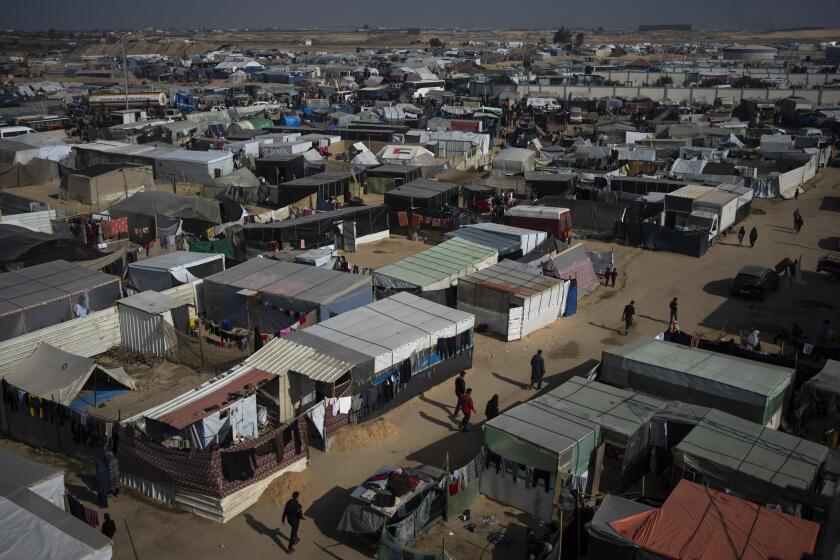‘Dumb’ Bombs Cause Heavy Damage in Basra : Air raids: The weapons cannot be targeted precisely. In Baghdad, ‘smart’ bombs are aimed at military targets.
Huge quantities of unguided “dumb” bombs have been used in the relentless U.S. air raids on Iraq’s second-largest city, according to U.S. military officials, lending credence to growing reports of civilian casualties and extensive residential damage in the area.
The bombing of Basra, a critical nerve center for the Iraqi army, stands in contrast to that of Baghdad, where Pentagon officials have shown films of laser-guided “smart” bombs that hit military targets, bridges and industrial sites in and around the capital with little damage to nearby civilian sites.
The precise weapons, including Navy Tomahawk cruise missiles and bombs dropped by Air Force F-117 Stealth fighters, were favored there in part because they are virtually invulnerable to the heavy antiaircraft net protecting Iraq’s capital.
The southern port city of Basra, by contrast, has relatively primitive air defenses and has therefore been assigned to less sophisticated carrier-based Navy A-6 attack planes, Air Force B-52s and F-111s dropping a combination of guided and unguided bombs, Pentagon officials said.
“These are clearly two different cities and two different areas,” one senior officer said. “Baghdad is more heavily defended and that’s why you use Stealth and stand-off weapons” such as cruise missiles. “Basra is more reachable by naval air and offers a lot more targets” that don’t require the precision of the F-117 and Tomahawk, he added.
Former U.S. Atty. Gen. Ramsey Clark, who visited Basra this week, said Thursday that he found “no pinpoint bombing there . . . much greater destruction than (in) Baghdad.” Clark said he saw residential areas, schools, a nightclub and a mosque that had been destroyed by the allied bombing of Basra.
Clark, a peace activist whose estimates of civilian casualties in the U.S. invasion of Panama exceeded tallies from some human rights groups by a factor of 10, said more than 150 civilians had been killed in Basra in the last several days. The official Iraqi news agency put the civilian death toll in Basra at 349 since the war began Jan. 17.
One government official dismissed Clark’s complaints about U.S. bombings as the product of selective, anti-American outrage.
“He should have gone into Kuwait in August (after the Iraqi invasion) if he was so interested in human rights violations,” the official fumed.
But other travelers have also catalogued wide devastation in Basra, including virtually all communications sites, refineries and government buildings. Drinking water, power and fuel are all non-existent and food is in short supply, the witnesses said. They said the round-the-clock allied bombardment left the city under a permanent pall of smoke and dust.
Some fleeing residents said this week that half of the 1.5 million residents of the city have left for safer quarters.
U.S. military officials said that many of the military targets in the Basra area--including storehouses, command posts and transportation hubs--are closely ringed by residential and commercial districts and that “collateral damage” was unavoidable.
“I have seen bomb damage assessment pictures that show residential areas immediately adjacent to significant military targets,” a senior military official said. “When you’re going after these things, there may be a short round. That’s unfortunate, but it happens.”
But Pentagon officials said much of the damage shown on Iraqi television and seen by witnesses may in fact have been caused by the extensive shelling the city received in the last stages of the Iran-Iraq War, which ended in 1988.
“I know some of this damage I’ve seen on TV I saw during the Iran-Iraq War,” said a senior government official. “They’re rerunning old scenes.”
U.S. intelligence sources said Basra is a critical U.S. target because it is a “major transport and communication node” for the large Iraqi field army in Kuwait.
Basra also has high cultural value to the regime of Saddam Hussein because Iraqi invested billions in rebuilding the city after the Iran-Iraq War.
U.S. planners have said they were paying particular attention to targets held dear by the regime because their destruction would demonstrate Hussein’s inability to defend his country.
“We regard that there are legitimate military targets in the city of Basra--rail and highway bridges over the Euphrates; communication facilities, both national and military; major naval repair depots. It’s really necessary to destroy all of those,” a defense official said.
But, this official insisted, “we don’t go out and bomb civilians on purpose.”
He and others at the Pentagon said that in the last several days, the Iraqis have been firing their surface-to-air (SAM) missiles without turning on their radar guidance systems, consequently damaging their own cities.
The radars, officials noted, were like a beacon to allied aircraft, which home in on the signals with anti-radiation missiles and blow up the launchers.
The Iraqis therefore have “just shot off the SAMs and let them go ballistic. They’re firing at random without locking onto targets. They don’t hit anything, they reach the end of their range and then they fall back to Earth with their complete warhead intact and they explode.”
More to Read
Sign up for Essential California
The most important California stories and recommendations in your inbox every morning.
You may occasionally receive promotional content from the Los Angeles Times.






